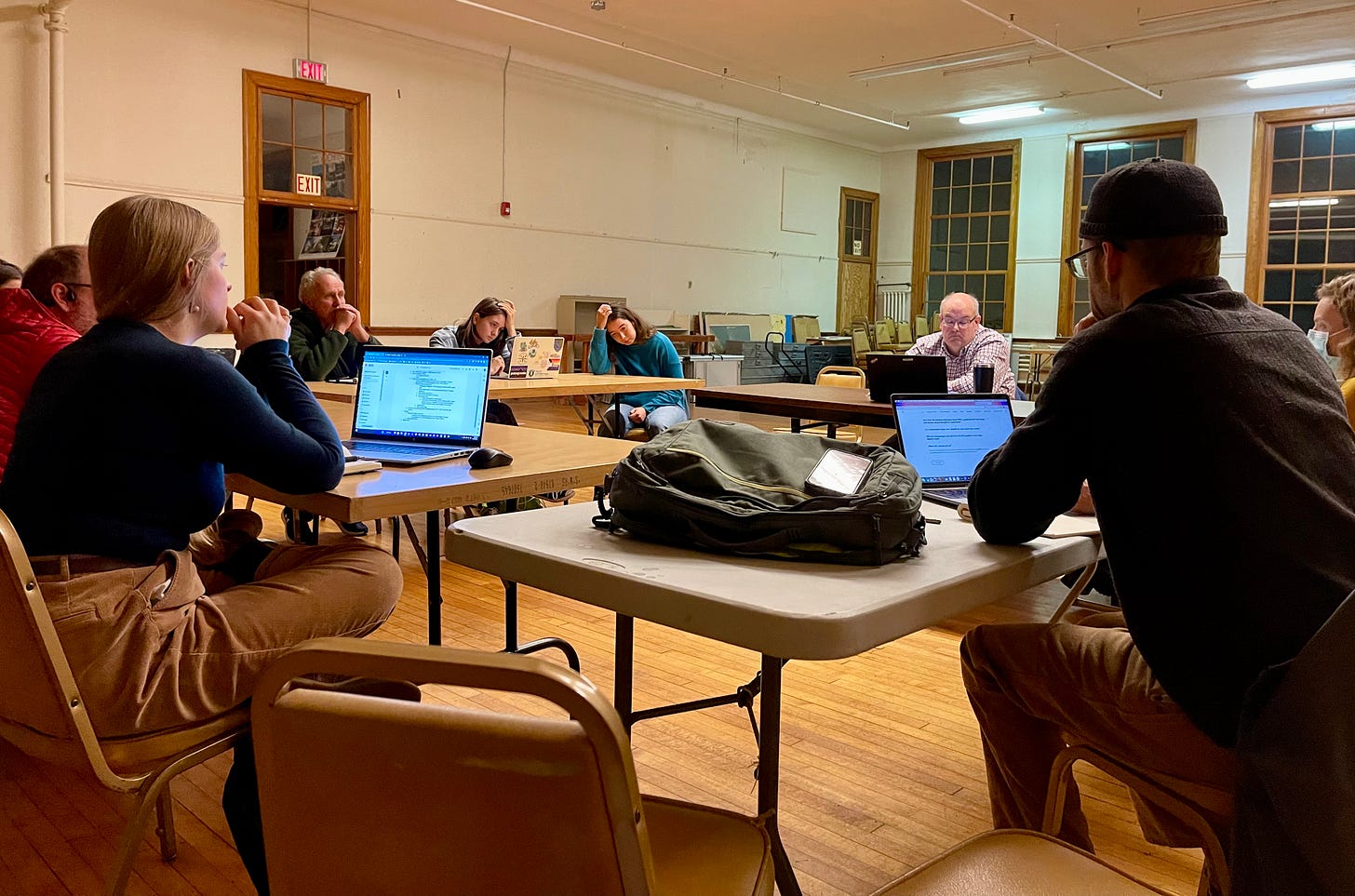Could Small Electric Cars Save MDI
Task Force on Climate Change Hears Acadia GEM report, talks budget
BAR HARBOR—A recent feature on Electrek by Micah Toll asked if “tiny, low-cost electric cars help save America’s cities from massive vehicles?”
A similar question can be asked about MDI which is dealing with the congestion of tourists and their cars as well as locals in Hancock County commuting. Electric cars don’t create emissions that hurt air quality.
Toll writes,
“LSVs may not be very common yet, but several companies are already producing interesting models. We’ve seen them built for commercial applications like parcel delivery as well as for both commercial and private use, like the Polaris GEM that was recently spun off into its own company. Unlike the GEM, which is designed as an open-air vehicle similar to a golf cart, Wink’s vehicles are enclosed like conventional cars. And they happen to come in at less than half the price.”
The GEM (battery powered, low speed) is already here and the town’s Task Force on Climate Emergency met on Tuesday and heard a report from Eben Salvatore about the Acadia GEM’s season. The company is co-owned by Salvatore and Jeff Young. Salvatore estimated that the electric cars covered 100,000 or more miles in its first year of operation. That equates to the same number of miles where drivers didn’t rely on fossil fuels, he said.
The new light-duty electrical cars tend to average $250 for a half-day rental. Salvatore said that a two-seat GEM cost them approximately $50k (starting prices are much lower) and the biggest difficulty for the company is getting the educational piece out there so that people know that the vehicles are available.
Bar Harbor’s Sustainability Coordinator Laura Berry commented that she’d like to see how the GEMs could be part of a bigger picture for regional transportation, especially concerning how tourists get to Bar Harbor from Bangor and then can spend the entire time here with different options that don’t involve fossil fuels. Those options could include GEMs, bikes, and Island Explorer busses.
The task force members asked Salvatore’s feelings on if the vehicles should be allowed on roads with posted speeds higher than 35 mph. He said he had concerns about collisions.
“I think it wouldn’t go well for the people in the GEM.” The company had one accident all summer when a driver ran into a parked car. Since the cars can’t go on higher-speed roads it prevents the GEMs from going all over the island. One member suggested possibly focusing efforts on small sections of state roads that enable the GEMs and similar low-speed electric vehicles to hook back into those lower-speed roads.
Town Councilor Joe Minutolo said, “Public transportation in Bar Harbor is a huge question for us.”
“If the park transportation plan changes happen there will be a ripple effect in how people move around here,” Salvatore said.
He also offered the town the use of the company’s 280 deep cycle gel batteries that are brand-new.
Government programs often incentivize these vehicles, which tend to have zero-carbon emissions, quiet operations, four wheels, and weigh less than 3,000 pounds and a low top-speed capacity.
The market for low speed electric vehicles is expected “to reach $7,617.3 million by 2025,” according to Allied Market Research. “It’s growing at a CAGR rate of 15.4%” between 2018 and 2025.
It’s believed that rising fuel costs, concerns about pollution and climate change and depleting fossil fuel reserves have helped to propel this growth. Westward Industries estimates that fuel costs for a vehicle like Acadia GEM are $350 a year as opposed to $2,000 for a gas-powered vehicle.
Earlier this year, Salvatore told the Bar Harbor Story that he drives his personal truck into Bar Harbor to work, parks it and then uses a GEM to run to meetings around town and in the park. He uses a quarter of his normal gasoline consumption, he says, by not using his truck.
Acadia National Park created a transportation plan in 2020 meant to guide transportation projects within the park and nearby communities. It calls for more Island Explorer busses and funding as well as reusing the Bar Harbor ferry terminal on Eden Street for parking and transportation.
Acadia National Park may be the first in the continental United States to allow low-speed vehicles to cruise on its park roadways, Salvatore said, which would make Acadia GEM the first company to offer that experience. Chyulu Hills National Park in Africa has recently deployed four electric cars to help its conservation efforts.
According to the United States Department of Transportation, the government is testing automated shuttles at the Wright Brothers National Memorial and Yellowstone National Park as part of its Emerging Mobility Pilot Program. These programs use low-speed, automated, electric shuttles. Acadia’s own Island Explorer shuttles are free and powered by propane, meant to reduce pollution and traffic congestion, but that’s not the same as the Acadia GEM, where tourists or locals rent the vehicles and drive on roads posted for less than 35 mph, creating their own independent experience in a way that lowers pollution.
EV CHARGER VISITS
The EV charger site visits were delayed this past month because of a health issue. The task force stressed that members wanted those charging sites to be accessible to the public, especially year-round residents and people who live in apartments or who might not have access to charging capabilities at their dwellings.
A recent article in the Oregonian by Gillian Flaccus speaks to the problems for some renters when it comes to charging their vehicles.
Last month, the Biden administration signed onto a $5-billion, five-year plan that would create charging stations on interstate highways throughout the country. Flaccus writes, “But states must wait to apply for an additional $2.5 billion in local grants to fill in charging gaps, including in low- and moderate-income areas of cities and in neighborhoods with limited private parking.”
About 1.5 million electric vehicles are in the U.S. And there are approximately 120,000 public places to charge those vehicles, but the distribution of chargers is uneven.
COMPETITIVE ENERGY SERVICES
In an effort to have a net-zero town, Berry has been working with Competitive Energy Services in hopes of the town attaining a fixed price agreement and focusing on renewable energy sources and procurement. There are 48 sites in the town, which use 2 million kilowatts of energy a year. This data, which is from the town’s Versant accounts, does not include the high school, but it does include Conners Emerson.
Though the town is the name on the Conners Emerson Versant bill, the school budget is actually paying that bill, not the municipal budget. There will have to be a decision about whether or not the school or the town’s name is on the bill. If the town’s name stays on the bill, it would have more control over sourcing that energy for Conners Emerson. Berry stressed that the decision would have to be made, looking at which is most appropriate in terms of climate goals and budgeting.
Conners Emerson does currently have a fixed price agreement.
BUDGET RECOMMENDATIONS
Chair Ruth Poland asked the task force members what projects they wanted to propose to the town’s manager and advocate for at the town council. She ran through the priorities the task force had previously come up with. Those included wastewater audits, green power brokers, including using biodiesel to replace heating oil, “solar panels everywhere,” education of resources for funding, and public transportation infrastructures, matching grants for EfficiencyME rebates, and e-bike patrols.
The town’s budget has a specific set-up where many components are stipulated by law, according to Minutolo. “Each department is responsible for their own building perse. That’s the way it’s budgeted and how it has to be spent.”
That makes any options like specifically making things like solar panels a normal piece of the budget, a bit more difficult. In the budget, energy building renovations are separated out by municipal building. Specifically having a sustainability or efficiency budget would be a realignment, Berry said.
However, Minutolo said, “When you fragment it like that, how much bite can you get out of each project?”
He asked for a consolidated list of what the wants and needs look like overall—"what we’re looking at, what we need to beef up a little more.”
He stressed that the town had to make sure that the total budget increases in a way “that doesn’t crush people.”
He also advocated for knocking off the projects one at a time and having a strategy where things can be crossed off a master list of projects and then move down that list to the next project.
Poland asked, “What are the projects that should be embedded in the budget for now?”
She asked Berry to come back to the meeting and report with numbers and needs for the budget.
Later in the discussion about a miscommunication between the task force, town staff, and A Climate to Thrive, Berry added that the formalization of the projects and agreements is going to have to happen as the town puts more resources into the projects.
LINKS TO LEARN MORE
https://www.alliedmarketresearch.com/low-speed-electric-vehicles-market
https://legislature.maine.gov/statutes/29-A/title29-Asec2089.html
https://www.nps.gov/acad/planyourvisit/island-explorer.htm
https://www.nps.gov/acad/learn/management/transportation-plan.htm
https://www.the-star.co.ke/news/2022-10-23-electric-cars-deployed-to-chyulu-hills-to-curb-pollution/
https://barharborstory.com/2022/07/29/the-new-vehicles-on-the-streets/
https://electrek.co/2022/11/08/wink-motors-electric-nevs-lsvs/











